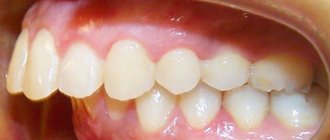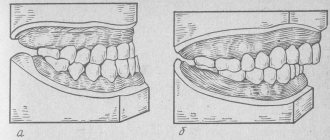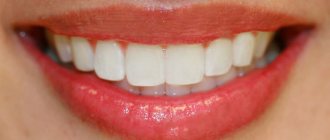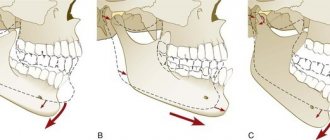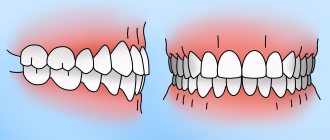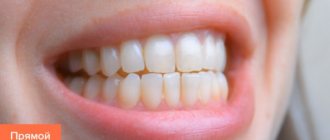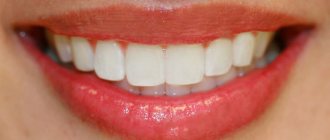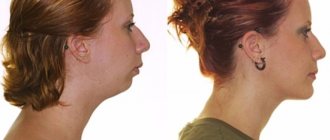Not everyone can boast of a Hollywood smile and perfectly straight rows of teeth. Aesthetic indicators depend on many factors.
The term “bite” is characterized by the position of the rows of teeth when the jaws are clenched. With normal functions of the dentofacial apparatus, facial aesthetics are not disturbed. The word “orthognathia” is translated as “true arch”, which is located exactly along the same vertical line with the facial bone. The ideal is perfectly straight teeth and tightly spaced incisors. This is what they look like for most people. When making corrections, doctors strive to achieve this result.
Characteristic
Orthognathic occlusion can be diagnosed by a number of specific signs. But it should be remembered that there are slight differences between adults and children.
In adults:
- Each incisor (except for the central lower incisors and upper “eights”) has two antagonists.
- The crowns of the lower teeth have a slight slope towards the middle of the oral cavity.
- The dental arches are approximately the same size.
- The front teeth are in a symmetrical position in relation to each other.
- The lower incisors overlap the upper ones according to the scissor principle by about a third of their total height.
- There are no interdental spaces and excessive crowding of teeth.
- All dental units decrease in height from the center to the posterior sections. The only exception is fangs.
- The cusps of the upper teeth on the buccal side are located outside the cusps of the lower teeth.
- Facial aesthetics are harmonious.
In children:
- the upper jaw arch is in the shape of an ellipsoid, the lower one is in the shape of a parabola;
- there is a small gap between the teeth;
- complete symmetry of the crowns;
- The top row overlaps the bottom row by one third.
Signs
The characteristics by which orthognathic occlusion is determined can be divided into three groups according to the specific area they will relate to: separately to the chewing teeth, separately to the central group and in general to the entire dental arch.
The whole arc
- Both arcs take the form of regular curves: the lower one is a parabola, and the upper one is an ellipsoid.
- When the jaws come together, most teeth touch two antagonist teeth. They are called secondary and main, which is of the same name. As an exception, the upper “eights” and lower incisors are called - they have only one antagonist.
- Of the two antagonist teeth belonging to the upper row, the secondary one stands deeper in the arc. The opposite statement will be true for antagonists to the teeth of the lower arch - the secondary one is the upper one, standing in front.
- Approximal surfaces (that is, those facing adjacent teeth of the same row) have certain points of contact at which teeth of opposite rows touch when closing each other.
- Not taking into account the canines (as an exception), the crowns of all other teeth gradually become smaller in height as you move from the central to the posterior.
- The crown parts of all lower teeth are inclined slightly in the middle of the mouth, and the roots are tilted outward, towards the cheeks. With the upper ones, the situation is the other way around: their roots are directed to the inner part, and the crowns are directed to the outer part.
- The top row overlaps the bottom row.
The reason for this is the smaller size of the lower arc. This is ensured by certain relationships between the dental arches and the alveolar and basal arches. Upper jaw: the basal jaw is smaller than the alveolar jaw, which in turn is smaller than the dental jaw. At the bottom, the opposite relationships are observed.
What rules must be followed to form a correct bite in a child, watch the video:
Frontal group of teeth
Signs that characterize the type of closure of teeth located in the anterior protruding areas of the jaws:
- the midlines that lie between the two central incisors of both the upper and lower jaws must be located on the same straight line;
- The overlap of the lower crowns with the upper ones occurs in a scissor-like manner, with the size of the overlap being a third of the length of the crown, that is, 1.5-3 mm.
Chewing teeth
The characteristics of the closure of chewing teeth can be characterized in two ways, in two main directions – buccal-palatal and anteroposterior.
Bucco-palatal direction:
- In the lower row, the lingual cusps lie deeper (closer to the inner part) of the palatal cusps of the upper one.
- Outside the cheek cusps (lower teeth) there are similar cusps of the upper teeth, and vice versa. This leads to the coincidence of the upper tubercles with the lower longitudinal grooves. The same happens in the opposite direction.
- The external (buccal) and internal (lingual) cusps are located on both sides of the jaw at different levels.
Anterior-posterior direction:
- The position of the anterior outer cusp of the upper first molars is between the outer cusps on the outer side of the mandibular first molars in the transverse groove.
- In the lower row (from the last molar to the premolars), the chewing surfaces form a concave sagittal plane.
The plane formed by the chewing surfaces of the lower row completely repeats this shape and coincides with the already described sagittal concave, while being convex.
It should also be added that there should be no gaps or gaps between individual crowns .
All signs of orthognathic occlusion, considered ideal, are checked in a state of maximum closure.
However, most of the time the jaws are open, being in a state of rest (physiological).
With an orthognathic occlusion in this condition, there will be some free space between the two rows of teeth, lower and upper, which usually ranges from 2 to 4 mm .
What does it matter
Orthognathic bite allows you to avoid many problems. It provides:
- Prevention of gastrointestinal diseases. The position of the jaw arches is optimal for the normal chewing process, which ensures high-quality initial processing of food.
- Normal breathing.
- Clear diction.
- Aesthetic appearance. A person can smile normally and not experience psychological discomfort.
- Avoiding tooth wear.
- Avoiding trauma to the tongue, gums and buccal mucosa.
Also, correctly positioned dentition greatly facilitates hygienic care of the oral cavity.
Types of abnormal bite
An abnormal bite is characterized by incorrect location of the alveolar openings of the molars or incisors, the presence of congenital anomalies of the bone structure of the head, and post-traumatic violation of occlusion. To correct it, trainers, braces are used, and surgery is performed.
Deep bite
The front upper incisors cover the upper ones by more than ⅓. In severe situations, their end ends at the gums of the lower teeth. The contact between the incisors and molars is disrupted. An alternative name for occlusion is traumatic, frontal overbite, decreasing, disocclusion.
A person develops “bird-like” facial features. The upper half flares out, so the chin looks abnormally narrow. The lower lip is turned outward, the mouth is small. With a deep bite, difficulties arise when chewing food, injuries to the mucous membranes, and thinning of the enamel.
Often pathological occlusion leads to deterioration of the oral cavity:
- severe headaches;
- decreased tone of the chewing muscles;
- dysfunction of the temporomandibular joint;
- friction of the mucous membranes of the cheeks, the appearance of wounds.
Deep occlusion can in most cases be corrected with long-term retainer therapy.
Open bite
The pathological process is characterized by a strong vertical displacement of the dentition of the jaws. An open bite develops due to sucking on pacifiers and fingers. Bad habits gradually shift the dentition. The sucking reflex can be traced even in adulthood: unconscious sucking or biting of the tongue.
Pathological occlusion is diagnosed when the molars are in close contact, but a large gap forms between the lower and upper incisors. Surgery is performed in the presence of speech therapy disorders or pain during eating.
Crossbite
Crossed occlusion occurs in people who use only one side of the jaw or incisors to chew food. The development of a pathological process can be provoked by a congenital anomaly of the jaw, a mechanical injury, as a result of which the chin is shifted to the left or right.
This type is considered one of the most severe dental diseases. Unilateral cross occlusion can be diagnosed if one or more of the upper incisors extend beyond the lower ones. A bilateral violation is accompanied by a displacement of the entire jaw, in which the dentition does not close simultaneously on the left and right sides.
Occlusion in childhood can be provoked by:
- rickets;
- cleft palate;
- lack of calcium and vitamin D;
- cleft lip;
- inflammatory process in the temporomandibular joint;
- disturbances in the development of cranial bones during embryonic development.
To treat crossover anomalies, the Herbst device and metal braces are used. In case of congenital diseases, plastic surgery is performed to restore the palate.
Distal bite
Such occlusion is diagnosed when the upper jaw is highly developed, and the lower jaw is narrowed and small in size. The teeth on top move forward, almost completely covering the bottom ones. The root elements do not close, and vertical cracks form. Distal occlusion is diagnosed with various types of prognathia.
Along with the anomaly, speech disorders are formed. Speech therapy disorders prevent a person from speaking normally: pronouncing hissing consonants and guttural sounds. When occlusion occurs, the shape of the face changes. Due to a strongly protruded jaw, the lower lip sinks, the chin looks massive and heavy.
Mesial bite
An alternative name is reverse, progeny. Pathological occlusion is detected with pronounced development of the lower jaw. At the same time, the orthodontist notes that it is moving forward greatly. In this position, closure of neither the molars nor the anterior incisors is possible.
The situation is the opposite of an orthognathic bite - the lower jaw overlaps the upper jaw. In severe cases, gaps form between the incisors, which prevents normal biting and chewing of solid food. The gap between the teeth is clearly visible when a person smiles. The main load falls on the chewing molars.
Immediate surgical intervention by an orthodontist is required only in cases where traumatic occlusion is diagnosed using x-rays. In this position of the jaws, the development of constant bleeding is observed. Regular injuries to soft tissues lead to chronic gum disease, because the lower ones completely cover the upper incisors.
Against the background of the reverse, cross and open occlusion occurs. In this case, it is difficult to implant prostheses. When progeny occurs:
- three and curvature of the lower dentition;
- crowding;
- formation of tartar, caries, inflammation of soft gum tissue;
- early loss of canines and molars;
- thinning of cartilage tissue, pain, difficulty in chewing movements.
When is treatment needed?
As a rule, no treatment is required for orthognathic occlusion. But there are also some anomalous processes when correction may still be necessary. For example:
- The incisors are too large in relation to the rest of the dentition.
- Unevenly positioned dental units in relation to the rest in the row. This situation spoils the smile and causes psychological discomfort to the person.
- Traumatic injuries to the jaw.
Each specific clinical case has its own characteristics and the final decision on the need for therapy is made by the orthodontist.
Anatomy and physiology of the dental system
When it comes to occlusion, not only the location of the teeth is important, but also the functions of the remaining elements of the dental system. These are the upper and lower jaws, jaw joints and muscles that ensure the process of chewing and swallowing.
The greatest load on the teeth occurs when chewing. It is important that at this moment the load is evenly distributed on the surface of the teeth. This way hard tissues will retain their strength and structure longer. Otherwise, the teeth will quickly wear out. This threatens with caries, wedge-shaped defect, gum disease and final tooth destruction.
Under the physiological norm, the position of the jaws should be parallel. The lower jaw resembles a parabolic arch, and the upper jaw is a semi-oval. The coordinated functioning of the jaw joints is also important - without discomfort, clicks and crunches.
What to do if your bite has changed
If your bite begins to change, you need to contact your dentist. After conducting a physiological examination, the specialist will order an x-ray to identify the specific problem. Depending on the cause of the changes, a plan of treatment measures is drawn up to restore the functioning of the jaw and the normal closure of the teeth.
Treatment most often involves wearing braces or aligners. The doctor selects a design that corresponds to the type and degree of the existing disorder. At a young age, defects are corrected much faster and easier than at a more mature age. Children may be prescribed trainers—devices that are worn for several hours a day.
Orthognathic surgery
September 12, 2016
No matter how much we repeat the hackneyed phrase that “one is guided by the mind,” a pleasant appearance, in particular the face, plays a significant role in success in life. What if you were unlucky with your face from birth? Or, God forbid, was it damaged as a result of injury? In many cases of malocclusion and severe disharmony of facial shapes, it is worth turning to maxillofacial correction, and specifically to orthognathic surgery. This relatively young field of medicine, thanks to the latest advances in science and technology, not only restores correct bite and other vital functions of the dental system, but also restores patients’ self-confidence and joy of life. Improvement in appearance, as a rule, pleases even more than comfort and health.
Let's take a closer look at this section of surgery. Moving the upper or lower jaws during surgery, correcting malocclusions and facial shape - this is what orthognathic surgery is all about. This is general information. But in what cases of malocclusion is it worth considering surgical intervention, what are the stages of preparation for the operation, how it happens and how to go through the rehabilitation period without complications - it is better to ask a practitioner about this.
Andrey Nikolaevich Senyuk, a maxillofacial and aesthetic surgeon with more than twenty years of experience, candidate of medical sciences, chief physician and director of the maxillofacial surgery clinic “Face Smile Center,” is ready to answer these and other questions.
Does malocclusion always imply the need for orthognathic surgery?
It depends on the nature of the defect. Malocclusion is distinguished as dentoalveolar and skeletal. And if in the first case the correct relationship of the teeth is corrected by an orthodontist, then only orthognathic surgery can restore the desired relationship of the jaws. This is where the most important stage of treatment begins—the interaction between the orthodontist and the surgeon. Achieving complete success in this process is always the result of a combination treatment. Indications for surgical intervention are: open bite, asymmetry of facial proportions, strongly protruding lower jaw, the so-called gummy smile, pronounced chin slope. This is aesthetics. Physiological disorders include difficulties with chewing food, speech impediment, breathing problems, and the development of chronic pathology of the temporomandibular joint.
Obviously, the type of defect leads to differences in the types of surgical operations?
Yes. There are three main types of orthognathic operations: maxillary osteotomy, mandibular osteotomy and chin osteotomy. In the process of maxillary osteotomy, it becomes possible to move the entire jaw as a single unit. Then it is given the correct position in relation to the lower one. With a mandibular osteotomy, bone cuts are made behind the molars (hence the need to first remove all wisdom teeth) and the jaw is set in the desired position. To secure the jaws, special plates made of medical titanium are used. Osteotomy of the chin is part of a set of measures for surgical correction of the chin in order to improve its aesthetic appearance.
What do you need to know before deciding to undergo orthognathic surgery?
First of all, you need to clearly understand that this process is very slow, since orthodontic preparation for surgery alone can take about a year. All this time the patient wears a brace system. This is the specificity of the treatment. In addition, wisdom teeth must first be removed, because... The saw line of the jaw usually falls on these places. Further. Orthognathic surgery can only be performed upon reaching the age of 18, when active skeletal growth ceases. Statistically, an age group of 20 and 30 years can be distinguished. It is at this age that formed self-awareness and an adequate approach to the treatment process are most characteristic. Finally, individual response to anesthesia is also taken into account when deciding whether to undergo orthognathic surgery.
Are there any peculiarities in the preoperative period?
After orthodontic preparation, the patient moves to the surgeon's group. Here, too, a number of manipulations are required: facial anthropometry taking into account individual parameters, computed tomography and its analysis, planning the necessary movements of the jaws in a special program. Before the operation itself, several conditions must be met: stopping food intake 12 hours before the appointed time, including water; it is strictly forbidden to perform the operation in case of illness: a cold or even just a fever, as well as problems with digestion. In this case, the operation is postponed until complete recovery. If the patient is routinely taking any medications, the doctor should be aware, since some of them may be incompatible with anesthesia or affect blood clotting.
How is the operation performed?
The operation itself lasts from 1 to 6 hours, depending on the volume and complexity of the surgical intervention. There are no reserves left on the facial tissues outside, because... All surgical procedures are performed in the oral cavity. To fix the displaced jaw, plates made of special medical titanium are used. The wounds are then sutured. From this moment, an equally important rehabilitation period begins.
What symptoms of the postoperative period are considered normal?
Unfortunately, it is not possible to avoid a number of unpleasant but inevitable symptoms after such an operation, such as: temporary swelling and bruising in the cheeks and lips, nausea, sore throat, nasal congestion, difficulties with proper oral hygiene, and minor weight loss.
What are the possible complications with such operations?
I want to say that if all stages of orthognathic surgery are carried out correctly, then complications occur extremely rarely. However, when performing an osteotomy of the lower jaw, due to its anatomical structure, a decrease in the sensitivity function of the ternary nerve is possible. This manifests itself in the form of partial numbness in the area of the lower lip and has practically no effect on facial expressions. Complications such as bleeding and inflammation depend on the individual characteristics of the body and on compliance with the doctor’s recommendations.
How long does the rehabilitation period generally last?
The early stage of rehabilitation lasts 3 weeks, after which the patient returns to his professional activities. Further restoration of the body is the work of the body itself. This implies a gentle regimen of exercise, both physical and vitamins and physiotherapy.
Preventing Changes
Over time, the correct arrangement of dental units during orthognathia may change. Therefore, even in adults, you should monitor the safety of your bite. Possible reasons for changes:
- Periodontal diseases.
- Loss of teeth (due to caries, age-related changes, injuries).
- Improper breathing (oral breathing). It occurs due to frequent or chronic ENT pathologies.
To preserve your bite, such problems must be corrected immediately. Expert recommendations:
- daily proper oral hygiene;
- surgical restoration of teeth after their removal;
- timely treatment of ENT diseases.
Why is there so much talk about physiological occlusion?
Due to a number of reasons (diseases of periodontal tissues, severe destruction and premature loss of teeth, increased wear of dental crowns, traumatic deformation of the jaw, congenital anomaly, etc.), the closure of teeth is disrupted, causing disruption of chewing function. The chewing muscles, jaw joints, and periodontal tissues surrounding and supporting the teeth begin to experience significant overload, which can lead to:
- to loss of mobility of the lower jaw;
- to distortion of facial proportions;
- to diction disorders;
- to the breakdown of expensive crowns, bridges and prostheses;
- to implant rejection.
The consequences of malocclusion can even be diseases of the heart and blood vessels, internal organs and the musculoskeletal system. To maintain health for many years, you need to listen to the recommendations of dental therapists and not neglect the consultation of an orthodontist - a specialist who diagnoses dental anomalies and corrects bite.
Prevention of bite changes in children
To maintain an orthognathic bite, you need to start taking proper care of it from birth. There are a number of preventive measures that will help do this. Here is their list:
- Breastfeeding (if possible). It helps in creating the necessary load on the tongue and perioral muscles.
- When bottle-feeding, hold the bottle correctly (at a right angle to the gum, without pressing on the lower jaw).
- Use the pacifier as little as possible and remove it completely by the age of two.
- Avoid bad habits (sucking fingers or toys, biting cheeks, etc.).
- Include more solid foods (fresh vegetables and fruits) in your diet.
- Control proper breathing (nasal breathing).
- Watch your posture.
- Engage in the prevention of pathologies associated with impaired metabolism and absorption of calcium.
- Make sure you have the correct position while sleeping (avoid throwing your head back and blocking your nasal breathing).
Heredity is of no small importance. If one of the parents had bite defects, then the child may inherit the model of jaw structure from them. To correct the deficiency at an early age, you need to consult an orthodontist in time.
Orthognathic occlusion belongs to the category of functional occlusions. According to statistics, it is the most common among people in the modern world. If you regularly prevent dental diseases and devote enough time to oral hygiene, you can maintain healthy teeth for life.
Why is it important for the jaws to close correctly?
You may be surprised, but orthodontic abnormalities can go unnoticed. A malocclusion is not always crooked, misaligned teeth, a clear discrepancy in size, or jaws not closing together. Incorrect closure of those same “chewing tubercles” in itself does not allow the chewing load to be distributed correctly.
If we develop the idea further, it turns out that even one “flat” filling, without precise restoration of the chewing surface, or a crown placed incorrectly in height can disrupt the physiology of correct occlusion. Moreover, the consequences of violations will be revealed over the years.
Our brain makes the first impression of a person in 0.5 seconds
First, let's ask ourselves the question: “ Is facial beauty and harmony really so important in the life of an ordinary person? “If you believe folk wisdom, the answer will be negative. And this argument can reassure anyone. But why, then, have people all over the world since ancient times still not calmed down in searching for new ways to decorate their faces?
The answer to this question, I think, is obvious to everyone. And this is confirmed by numerous studies by psychologists: The first impression of a person , and therefore the further attitude towards him, the brain, regardless of us, makes within 0.5 seconds precisely on the basis of a look at the face . At the same time, the beauty of the figure, breast size, waist circumference, leg length and other body characteristics are secondary. For example, I won’t meet a girl if I don’t like her face . Even if the figure meets the highest standards. And vice versa - if you like the face, then sometimes you don’t pay attention to the flaws of the figure , they become unimportant.
Beauty opens all doors
The desire to be attractive is perhaps the most important desire of people. It is known that an attractive face helps to establish interpersonal contacts, facilitates solving social problems and, most importantly, gives self-confidence . The results of numerous sociological surveys and studies have confirmed that a person’s attractiveness plays a very important role in his destiny. It is well known that beautiful people are more likely to get higher-paying jobs, have happier marriages, and have a wider social circle. And these are not empty words! It’s not for nothing that millions of people around the world agree to change their appearance by performing various surgical interventions. And the most interesting thing is that they actually get what they want! (otherwise plastic surgery would have ceased to exist long ago) The surgeon’s scalpel really allows you to change your life for the better . It is only important that he has a correct and holistic idea of beauty, can accurately identify the “problem” and eliminate it in the most appropriate way.
It happens that a person does not like his own face . Or some part of it: nose, ears, lips. Relatively recently, nothing could be done about this, and I had to console myself with folk wisdom: don’t be born beautiful, but be born happy . Currently, the situation has changed radically . of the ears (otoplasty), increasing the volume of lips and cheekbones have become familiar and routine But the opportunity to completely change the shape of the face has appeared in our area relatively recently. This direction in the specialized literature is called orthognathic and orthofacial surgery . What does this mean? The prefix "ortho-" means "correct" . That is, these interventions are aimed at creating the correct bite and the correct face.
How are orthognathic surgeries performed?
Any modern orthonic procedure is performed using internal access to the oral cavity. This means that there will be no external cuts, wounds, or scar tissue. The type of anesthesia is also selected in each specific case - it all depends on the type of operation. The average duration of the procedure is from 30 minutes to 5 hours, respectively.
Benefits of jaw surgery:
- “Turnkey” harmonization – the operation allows you to eliminate both functional and aesthetic problems;
- Monitoring the condition after surgery - the doctor monitors the recovery process until the patient is completely satisfied with the result;
- Modern surgical intervention is as gentle as possible, on an outpatient basis, without the need for a long break from work.


